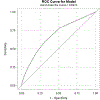Risk Factors for Stroke in Patients With Sepsis and Bloodstream Infections
- PMID: 30896327
- PMCID: PMC6476655
- DOI: 10.1161/STROKEAHA.118.023443
Risk Factors for Stroke in Patients With Sepsis and Bloodstream Infections
Abstract
Background and Purpose- Sepsis has been identified as a trigger for stroke, but the underlying mechanisms and risk factors that predispose patients with sepsis to increased stroke risk remain unclear. We sought to identify predictors of stroke after sepsis and bloodstream infections. Methods- The 2007-2009 California State Inpatient Database from the Health Care Utilization Project was used to identify patients over the age of 18 years and hospitalized with sepsis or bloodstream infection defined by International Classification of Diseases, Ninth Revision codes. Patients who died during their sepsis hospitalization were excluded. The primary outcome was a primary diagnosis of ischemic or hemorrhagic stroke on a subsequent hospitalization within 1 year. Associations between risk factors, also defined by International Classification of Diseases, Ninth Revision codes, and stroke were analyzed using multivariable logistic regression. A composite risk score was generated to predict stroke risk. Results- Of 121 947 patients with sepsis, 0.5% (n=613) had a primary diagnosis of stroke within a year of their sepsis hospitalization. Significant predictors for stroke were identified. A score was generated from these risk factors with points assigned based on regression coefficients: valvular heart diseases (1 point), congestive heart failure (1), renal failure (1), lymphoma (2), peripheral vascular diseases (2), pulmonary circulation disorders (2), and coagulopathy (3). The C statistic for the receiver operating characteristic curve for the score was 0.68. The risk of stroke increased 43% (odds ratio, 1.43; 95% CI, 1.37-1.48) per-point increase in the score. The effect of increase in score was greater among younger patients. Conclusions- Risk factors and a composite risk score for stroke may help identify a subpopulation of sepsis patients that could be targeted to reduce the short-term risk of stroke after serious infections.
Keywords: epidemiology; heart failure; pulmonary circulation; risk factors sepsis.
Figures
Similar articles
-
Sex-Related Differences in the Risk of Hospital-Acquired Sepsis and Pneumonia Post Acute Ischemic Stroke.J Stroke Cerebrovasc Dis. 2016 Oct;25(10):2399-404. doi: 10.1016/j.jstrokecerebrovasdis.2016.06.008. Epub 2016 Jun 28. J Stroke Cerebrovasc Dis. 2016. PMID: 27363622 Free PMC article.
-
Risk of Acute Stroke After Hospitalization for Sepsis: A Case-Crossover Study.Stroke. 2017 Mar;48(3):574-580. doi: 10.1161/STROKEAHA.116.016162. Epub 2017 Feb 14. Stroke. 2017. PMID: 28196938 Free PMC article.
-
Incident stroke and mortality associated with new-onset atrial fibrillation in patients hospitalized with severe sepsis.JAMA. 2011 Nov 23;306(20):2248-54. doi: 10.1001/jama.2011.1615. Epub 2011 Nov 13. JAMA. 2011. PMID: 22081378 Free PMC article.
-
Psychiatric Hospitalization Increases Short-Term Risk of Stroke.Stroke. 2017 Jul;48(7):1795-1801. doi: 10.1161/STROKEAHA.116.016371. Epub 2017 May 23. Stroke. 2017. PMID: 28536168
-
Diabetes mellitus and community-acquired bloodstream infections in the critically ill.J Crit Care. 2014 Feb;29(1):70-6. doi: 10.1016/j.jcrc.2013.08.019. Epub 2013 Oct 3. J Crit Care. 2014. PMID: 24090695
Cited by
-
Analysis of Risk Factors and Clinical Indicators in Bloodstream Infections Among Patients with Hematological Malignancy.Cancer Manag Res. 2020 Dec 31;12:13579-13588. doi: 10.2147/CMAR.S289291. eCollection 2020. Cancer Manag Res. 2020. PMID: 33408527 Free PMC article.
-
Association between ischemic stroke and pyogenic spondylitis in Korea: Nationwide longitudinal cohort study.J Cerebrovasc Endovasc Neurosurg. 2023 Jun;25(2):143-149. doi: 10.7461/jcen.2023.E2022.09.001. Epub 2023 Jan 17. J Cerebrovasc Endovasc Neurosurg. 2023. PMID: 36647233 Free PMC article.
-
Machine learning model to predict sepsis in ICU patients with intracerebral hemorrhage.Sci Rep. 2025 May 10;15(1):16326. doi: 10.1038/s41598-025-99431-9. Sci Rep. 2025. PMID: 40348861 Free PMC article.
-
Long-term risk and predictors of cerebrovascular events following sepsis hospitalization: A systematic review and meta-analysis.Front Med (Lausanne). 2022 Nov 25;9:1065476. doi: 10.3389/fmed.2022.1065476. eCollection 2022. Front Med (Lausanne). 2022. PMID: 36507522 Free PMC article.
-
Assessing the performance of genetic risk score for stratifying risk of post-sepsis cardiovascular complications.Front Cardiovasc Med. 2023 Feb 28;10:1076745. doi: 10.3389/fcvm.2023.1076745. eCollection 2023. Front Cardiovasc Med. 2023. PMID: 36926049 Free PMC article.
References
-
- Di Carlo A Human and economic burden of stroke. Age Ageing. 2009;38:4–5. - PubMed
-
- Elkind MS V Why now? Moving from stroke risk factors to stroke triggers. Curr Opin Neurol. 2007;20:51–57. - PubMed
-
- Lee-Iannotti JK, Capampangan DJ, Hoffman-Snyder C, Wellik KE, Patel B, Tondato F, et al. New-onset Atrial Fibrillation in Severe Sepsis and Risk of Stroke and Death. Neurologist. 2012;18:239–243. - PubMed
MeSH terms
Grants and funding
LinkOut - more resources
Full Text Sources
Medical


